Protected areas are considered one of the most important tools to fight against the negative impacts of climate change. They play a critical role in the provision of ecosystem services such as clean water, soil conservation, storm protection, biodiversity conservation, and the regulation of local temperature and humidity. The ecosystem services that protected areas provide, which are crucial for human health and well-being, help increase community and livelihood resilience to climate change. As a result, protected areas have become a key component of adaptation measures identified by communities and governments. The ability of communities to adapt to climate change will depend just as much on the intact services that protected areas as their social, economic, and technological capacities.


Protected areas also serve as great laboratories to learn about and measure climate change impacts. In addition, they provide an opportunity to understand how to better manage natural resources and biodiversity in changing environments. To confront this emerging transboundary challenge, protected area managers are faced with the need to recognize and manage for new risks facing their parks such as invasive species; pests; increased forests fires, hurricanes, and storms; temperature changes; floods; droughts, etc. CPAM is working with partners to design a state-of-the-art capacity building program on protected areas and climate change. This program, to be launched in 2018, will promote a proactive adaptive approach to protected area management through a mobile seminar on the management of protected areas in the era of climate change. The program will also encompass the development of ecosystem specific climate change tools for protected area managers.

